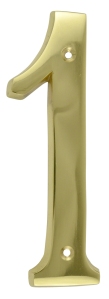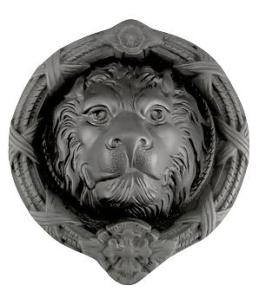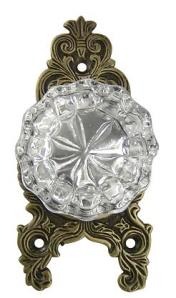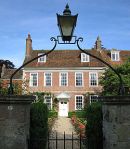Archive for the ‘Georgian’ Category
A Warm Welcome
Your front door is the welcome you present to all who approach your home. Colorful, traditional, quirky or grand, your style speaks to the world and beckons visitors to enter. Have you taken the time lately to study the message your front door is sending?
After a long brutal winter, your front entry may be showing the effects of weather through rust, tarnish, fading paint or dead plants. With warmer temperatures and sunny days ahead, take time to evaluate your entryway so it shines this spring. Here at Look in the Attic & Company, we have everything you need to dress this area up and welcome your guests in style.
First consider the paint. If the color is fading, or you’re ready for a change, liven up your door with a fresh coat of paint to get this project underway. Many homes feature traditional colors for entry doors, but lately, more personalized and unique door colors seem to be a trend.
Once the paint is dry, continue the updates with new entryway hardware. This traditional oval single-door deadbolt entryway set in Oil Rubbed Bronze finish provides an old-world elegance to your entry and is simple to install. We offer this complete set with tubular latch mechanisms, strike plates, complete knob sets, internal mechanisms, deadbolts and all mounting hardware. Everything you need for a successful installation is included.
Traditional Oval Single-Door Deadbolt Entryway Set
Next, add new house numbers for easy recognition of your street address. This often overlooked detail is attractive and makes your house stand out. The house number shown is made in solid brass and measures 6 inches tall. This durable solid brass casting comes complete with the mounting hardware and is available in Polished Brass (Shown), Antique Brass, Weathered Flat Black and Oil Rubbed Bronze.
6 Inch Tall Number 1 in Polished Brass
In addition to those updates, consider adding a new kick plate as well. Kick plates are a simple eye catching way to make your front entry stand out. Our kick plates come in a variety of finishes and heights. Our smallest plate is a non-standard 5 inches tall, with a width that can range from 27 to 42 inches. Our largest plate is a substantial 10 inches in height and a width range of 28 to 42 inches. Finishes for the plates offered include Polished Brass, Antique Brass, Antique Nickel, Satin Nickel, Oil Rubbed Bronze and more.
Lastly, complete your project with an elegant planter filled with colorful annuals. Look in the Attic & Company provides many choices for that finishing touch as well. We offer an assortment of planters in a variety of colors and styles to festoon your entryway in beautiful blooms. Below are just a few samples of our colorful planters.
Porcelain Floral Planter – Measures 17 Inches Tall with an Antique Bronze Finish Metal Base.
These featured improvements will declare a warm welcome to friends and neighbors. Let Look in the Attic & Company help with your front entry spring clean up for beautiful and lasting home improvements.
Ribbon and Reed Pattern Lion Door Knocker
Door knockers are a piece of ancient hardware history, and were at the height of their popularity about one hundred years ago. This was back in the days before cell phones and electric door knobs. It was common to find a home that had a bell-pull type door knob; these were typically on the more elaborately decorated homes of the wealthy. It was more likely that you would find a door knocker on a home instead.
Depending on your financial status depended on how decorative of a door knocker your home would have, or if you would have one at all. The wealthier you were, the more decorative the style. The wealthiest people would generally have a door knocker in the shape of an animal head, with a lion’s head being the most famous and popular ones. Door knockers like these can be found on some of the most famous buildings throughout the United States as well as the U.K.
The people who came up with the designs for many of the Ribbon and Reed style door knockers have a real eye for detail. They are exceptional at getting just enough detail in the animal heads while providing just a small amount on the ring. These items were typically cast in polished brass so they would stand out, but copper and pewter also became popular over the years.
We offer this piece in two sizes – and several different finishes to match the décor of your home. Antique bronze is the most popular, with the classic polished brass in a close second, followed by the oil rubbed bronze. As always, we include the mounting hardware for the piece with your order in the same finish you have selected to eliminate the hassle of having to match it from the hardware store, or having to guess what size screw(s) you will need.
Second Empire Architecture
The Second Empire architectural style was named after the French-inspired elements that appeared during the Second French Empire. The style was at the height of its popularity between 1865 and 1880, and while it was most popular in the United States, a variation can be seen in parts of France where it is called the Napoleon III Style. The Second Empire style has many elements specific to this time period, but, just like with any other style, some of the elements were influenced by other architectural time periods, like the Gothic Revival and Italianate styles.
In the United States, the style tends to be portrayed through rectangular towers with a steep mansard roof, which is the most typical of the French style from which it was derived. Most often, these roof crests have an iron trim, and sometimes they also have decorative lightening rods attached. The façade of the home is generally composed of wood, brick, or stone, and may also have paired columns. Most of the floor plans for Second Empire houses fit one of two styles: symmetrical with the tower in the middle or asymmetrical with the tower off to one side. Just like many things French, the more elaborately decorated and expensive-looking the better!
While there are a multitude of homes that were constructed in this style during the height of popularity, and most are still standing, the majority of the more well-known buildings are commercial properties, or government ones. In fact, so many government buildings were constructed during President Grant’s time in office that they were actually said to be created in the “General Grant Style”, rather than the Second Empire. The reason that so many large buildings were constructed in the Second Empire style is due to the versatility of their size.
Italianate Architecture in Europe and Australia
John Nash made a huge name for himself all throughout England and Wales when it came to designing new Italianate structures. Heavily influenced by Italian villas, he made this feature the primary focus of the majority of his buildings. This helps to distinguish his style from many of the other architects that made the Italianate style their own. Perhaps one of the reasons Nash became so popular is because he took so long to truly develop his own style. Many of his earlier pieces were a mish mash of other architects interpretations of the Italianate style, never having anything particularly characteristic of himself.
Some other architects dabbled in this style as well, despite having already made a name for themselves in other styles. One perfect example of this is Sir Charles Berry, who had made his name known for creating the House of Parliament building that we know today. Some of the more popular points of Italianate architecture were series of columns and arches decorating the front of the buildings, exemplary of the Italian Renaissance style, and an abundance of balconies accented by wrought iron and stone.
The Italianate style was also very popular in Australia, specifically for homes of governors. One very significant feature of the Australian architecture is its use of white and ivory for the exterior of the buildings. This gives them a much cleaner look, while giving a nod to its ancient influences.
The interior design aspect of Italianate style features clean lines and everything built in. That is to say instead of creating basic rooms with little to no decoration and having to adhere it separately, everything is incorporated during the building process. Wood is not varnished or painted, but is displayed in its natural colors, there are no mitered corners. Furniture features straight, clean lines, and is strong in style.
Fluted Glass Door Knobs
Diamond-like sparkle when the light hits them right, these modern recreations of fluted glass knobs, bring style and elegance to your home. Fluted glass knobs experienced a boom in popularity during the 1920’s to the 1930’s. The style has its origins in the Victorian period, the Regency style, with solid brass construction and a polished brass finish is re-emerging as a popular choice.
The Regency Single Dummy Fluted Door Knob set includes Rosette Screws, Crystal Knob and Rosette Plates. There are many styles to choose from including Privacy Locking sets, Passage sets and Double Dummy. There are also many finishes available to match your particular decor; brushed nickel, antique brass, polished chrome and oil rubbed bronze.
The Single Dummy is for one side of a door and is most often applied to a non-latching door, or bi-fold closet doors. While designed in an antique fashion, the Fluted Glass Door Knobs are sized for standard doors with a 2 1/8 bore hole. The Regency Crystal Single Dummy Glass Door Knob with any choice of finish makes an excellent addition to any room of the home. Matching the finish to your furniture’s hardware such as dresser drawer pulls or even bathroom faucets, be it antique brass, brushed nickel, oil rubbed bronze or polished chrome, can really pull the room together. Ceiling fans and even nightstand lamps can be matched to the finish and makes for a well designed décor that will impress your friends and family, but most importantly, you’ll be satisfied.
Your love for the finer things, like quality Fluted Glass Door Knobs will show in your selection of antique styled hardware from LookInTheAttic.com. This hardware is perfect for matching Victorian period, 1920’s and 30’s or even eclectic styles of design for your home. Many online stores carry these styles of knobs. Try ArtDecoHardware.com or LookInTheAttic.com for a wide variety of styles and colors.
Georgian Architecture – A Mini History
The Georgian Style is a name that was given to a broad spectrum of architectural styles that were typical of English-speaking areas anywhere between the 1720’s and 1840’s. While there are many different subcategories within this broad span of time, the nomenclature was given for one main reason. Just like many other things during this time period, tribute was paid to the monarchs of England; the kings George the first through George the fourth, who reigned, not coincidentally, during the same time period of the architectural style.
While many of the subcategories have their own characteristic design elements and style, many of the examples of Georgian architecture have a handful of their own features that remain consistent throughout the time period. These include, but are not limited to the following:
- 1 or 2 story box style homes arranged symmetrically
- Panel, centered front door topped with an elaborate entablature
- Decoratively embellished cornice
- A chimney on each side of the home
- A portico in the middle of the roof
This style is found in nearly every town or city in the original thirteen colonies of the United States, and many southern states. Many plantation homes as well as universities were built in the Georgian style, or in the Gothic subculture. Brown University, Samford University and College of William and Mary are all perfect examples of this style, and some people say that the inspiration for Margaret Mitchell’s Tara was also an example of the style.
Just like with many other things associated with the English monarchy during this time period the Georgian architectural style lost popularity with the colonists shortly after the revolution. The result was yet another category of architecture, dubbed the Neo-Georgian style.
Both Commercial, Estates and Residential buildings were created in the Georgian Architecture movement across the Northern and Southern United States – extending even into Canada. When renovating these buildings, it is important to note that the interior and exterior hardware is still produced today. Check online for Georgian Architecture – companies such as LookInTheAttic and Copper Mountain Hardware still manufacture this style of Architectural hardware components.
More From The Pot O’ Gold
Here is another wonderful piece from our own pot of gold that we were fortunate enough to win in the most recent auction. This piece will be a little harder to market, since it’s more of a specialized piece, but I think the market is big enough that it won’t be too difficult to get a broad audience for it.
After all, flowers have been well loved for centuries, and often has special meaning for a variety of people. The design does limit the versatility of the piece slightly, but opens up several options that weren’t there before. A piece like this, perhaps in a different finish, or even an enamel one, would look absolutely darling in a nursery, or a little girl’s room. It is the type of piece that she probably wouldn’t grow out of, and would make a wonderful accent to the piece to hand down to her daughters or grand daughters one day.

This would also be a wonderful piece to brighten up an otherwise dull kitchen, bathroom, or even guest bedroom. Floral motifs are becoming increasingly popular, and are extremely easy to accessorize. The trouble with designs like this can be an abundance of items available, and this can lead to an overwhelming feeling, especially when you are trying to find just the right piece to make the room complete, or just the right design to truly match a floral bedspread or curtains.
This piece would also look great on a potting table, or in a gardening shed for anyone that has a love of gardening and flowers. Perhaps they have a space dedicated in their garage just for their hobby and need a sturdy yet whimsical design to compliment it. This flower drawer pull is the perfect accent to finish the space. This will be available in a variety of finishes as well, ensuring the most versatility for it.
Gorgeous Antique Drawer Pull
We have had many travels over the past year, and have found a multitude of little treasures. I absolutely adore finding new things all the time! To some of you, many of these pieces may look nearly identical, but nothing could be further from the truth! Each piece has it’s own little story to tell, and it’s own history. It can be so exciting finding this out, especially when they have a uniqueness to them that are hard to imagine!
These next few pieces have an amazing story to them, one that many people may be able to relate to. These are all pieces of furniture hardware that were recovered, when much else couldn’t be, from homes affected by Hurricane Katrina. It’s hard to believe to those that weren’t affected by it that this storm hit more than five years ago, but to some it feels like just yesterday.

The extent of the damage from the storm was so severe that there are still crews working to clean up and salvage anything and everything that they can. A group of us decided to spend some of our holiday time volunteering with one of these causes, and in the process was able to salvage some pieces as well.

This set of drawer pulls, like many that we will feature, came off of a dresser that was in great disrepair. You could tell it was once a very fine piece, and was probably nearly a century old, though it was hard to tell for certain. The wood was rotting away, and even slight touches made it fall apart. We were able to take some photographs of the piece, and are hoping to find a master carpenter willing to try and re-create it to it’s original splendor. Even if you don’t have an antique dresser to put these on, they will still be able to give any piece an old world feel.

Out of the Attic – Revisited; Drawer Pull Edition
Another wonderful edition to the attic that we completely forgot about. This exquisite drawer pull was located in an old outbuilding on a relative’s property. This particular relative, who asked to remain anonymous, was a hoarder of sorts, although they refused to admit it. They liked to collect everything and anything, especially metal objects.
Flea markets and yard sales often proved dangerous to their wallets; they wanted to take everything home with them, but couldn’t, though they tried. There was an entire section of the building devoted to nothing but hardware for cabinets, drawers, and dressers. It was in one of these drawers that we found this piece.

This piece is actually the drawer pull off of my grandmother’s dresser from when she was a child. The dresser and drawer pulls were handmade, as was most everything back then. It was made by J. Richardson, one of the finest woodworkers in the area, and my grandmother sketched out the design for the drawer handles herself. She was quite the artist, and could often be found sketching and doodling. The metalsmith that created this drawer pull took one of her sketches and applied the design to the metal piece.
The result was a gorgeous dresser with one of a kind accents that not only epitomized the spirit of my grandmother, but also held great meaning to her. The dresser was passed down through the female line, and was actually in my possession for a brief time. Unfortunately, a fire claimed the life of that piece, as well as the rest of my belongings. I’m not sure how the one drawer pull survived, but am thrilled beyond words that it did. This piece will be absolutely stunning in the oiled bronze finish, as well as brass.
Thanks to all of our fans and readers – we appreciate you.















